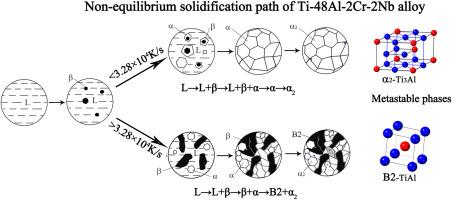Unravelling formation mechanism, phase stability and transitions of metastable α2 and B2 phases in laser additively manufactured Ti-48Al-2Cr-2Nb alloy
IF 4.8
2区 材料科学
Q2 CHEMISTRY, PHYSICAL
引用次数: 0
Abstract
The solidification route and microstructure evolution of TiAl alloys are strongly dependent on cooling rate, leading to a significant presence of ordered α2 and B2 phases in those fabricated using laser powder bed fusion (LPBF). However, the formation mechanisms, thermal stability and decomposition behaviors of this special phase composition remain unclear. In this work, we studied a Ti-48Al-2Cr-2Nb alloy fabricated by LPBF to understand its unique ordered phase structure. It was found that both the high-temperature α and β phases can nucleate and grow from the liquid TiAl, and subsequently transform to metastable α2 and B2 phases through ordered transition. The minimum cooling rate for the transition of β→B2 was determined as 3.28 × 104 K/s, with the content of the B2 phase increasing at higher cooling rate. Based on in-situ characterization and annealing treatment, both the ordered α2 and B2 phases were revealed to exhibit weak thermal stability, which were attributed to their special chemical composition deviated from that in equilibrium solidification due to insufficient atomic diffusion. This phenomenon also results in the formation of disordered γ phase and early precipitation of high-temperature α and β phases during heat treatment. This study provides valuable insights into the microstructural characteristic of Ti-48Al-2Cr-2Nb alloys fabricated at high cooling rate, offering guidance for the LPBF building and post heat treatment process.

激光增材制备Ti-48Al-2Cr-2Nb合金亚稳α2和B2相的析出形成机制、相稳定性和相变
冷却速度对TiAl合金的凝固路径和组织演变有很大影响,导致激光粉末床熔合制备的TiAl合金中存在大量有序α2和B2相。然而,这种特殊相组成的形成机理、热稳定性和分解行为尚不清楚。本文对LPBF制备的Ti-48Al-2Cr-2Nb合金进行了研究,以了解其独特的有序相结构。结果表明,高温α和β相均能在液态TiAl中形核生长,继而有序转变为亚稳α2和B2相。β→B2相变的最小冷却速率为3.28 × 104 K/s,冷却速率越高,B2相含量越高。通过原位表征和退火处理,发现有序α2和B2相均表现出弱热稳定性,这是由于原子扩散不足导致其特殊的化学成分偏离平衡凝固状态所致。这种现象还导致热处理过程中无序γ相的形成和高温α、β相的早期析出。本研究为高冷却速率制备Ti-48Al-2Cr-2Nb合金的显微组织特征提供了有价值的见解,为LPBF的建立和后热处理工艺提供了指导。
本文章由计算机程序翻译,如有差异,请以英文原文为准。
求助全文
约1分钟内获得全文
求助全文
来源期刊

Intermetallics
工程技术-材料科学:综合
CiteScore
7.80
自引率
9.10%
发文量
291
审稿时长
37 days
期刊介绍:
This journal is a platform for publishing innovative research and overviews for advancing our understanding of the structure, property, and functionality of complex metallic alloys, including intermetallics, metallic glasses, and high entropy alloys.
The journal reports the science and engineering of metallic materials in the following aspects:
Theories and experiments which address the relationship between property and structure in all length scales.
Physical modeling and numerical simulations which provide a comprehensive understanding of experimental observations.
Stimulated methodologies to characterize the structure and chemistry of materials that correlate the properties.
Technological applications resulting from the understanding of property-structure relationship in materials.
Novel and cutting-edge results warranting rapid communication.
The journal also publishes special issues on selected topics and overviews by invitation only.
 求助内容:
求助内容: 应助结果提醒方式:
应助结果提醒方式:


